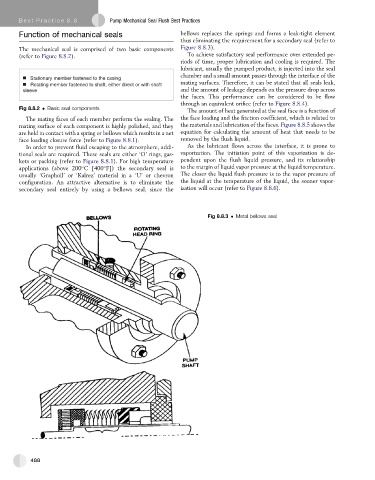Page 517 - Subyek Teknik Mesin - Forsthoffers Best Practice Handbook for Rotating Machinery by William E Forsthoffer
P. 517
Be st Practice 8 .8 Pump Mechanical Seal Flush Best Practices
Function of mechanical seals bellowsreplacesthe springsand forms a leak-tight element
thus eliminating the requirement for a secondary seal (refer to
The mechanical seal is comprised of two basic components Figure 8.8.3).
(refer to Figure 8.8.2). To achieve satisfactory seal performance over extended pe-
riods of time, proper lubrication and cooling is required. The
lubricant, usually the pumped product, is injected into the seal
chamber and a small amount passes through the interface of the
Stationary member fastened to the casing
Rotating member fastened to shaft, either direct or with shaft mating surfaces. Therefore, it can be stated that all seals leak,
sleeve and the amount of leakage depends on the pressure drop across
the faces. This performance can be considered to be flow
through an equivalent orifice (refer to Figure 8.8.4).
Fig 8.8.2 Basic seal components
The amount of heat generated at the seal face is a function of
The mating faces of each member perform the sealing. The the face loading and the friction coefficient, which is related to
mating surface of each component is highly polished, and they the materials and lubrication of the faces. Figure 8.8.5 shows the
are held in contact with a spring or bellows which results in a net equation for calculating the amount of heat that needs to be
face loading closure force (refer to Figure 8.8.1). removed by the flush liquid.
In order to prevent fluid escaping to the atmosphere, addi- As the lubricant flows across the interface, it is prone to
tional seals are required. These seals are either ‘O’ rings, gas- vaporization. The initiation point of this vaporization is de-
kets or packing (refer to Figure 8.8.1). For high temperature pendent upon the flush liquid pressure, and its relationship
applications (above 200 C [400 F]) the secondary seal is to the margin of liquid vapor pressure at the liquid temperature.
usually ‘Graphoil’ or ‘Kalrez’ material in a ‘U’ or chevron The closer the liquid flush pressure is to the vapor pressure of
configuration. An attractive alternative is to eliminate the the liquid at the temperature of the liquid, the sooner vapor-
secondary seal entirely by using a bellows seal, since the ization will occur (refer to Figure 8.8.6).
Fig 8.8.3 Metal bellows seal
488

